|
|

|

Cawdor Castle
near Inverness
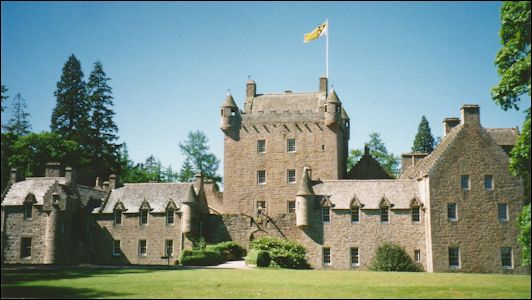
|
Cawdor Castle is located 12 miles east of
Inverness
in the eastern heart of the Scottish Highlands.
Set in wooded grounds, the present buildings date from the early 14th century, but the old drawbridge over the defensive ditch now takes tourists into the central square tower.
Once through the portcullis, you can visit the restaurant and bookshop to your left, or if you have paid to enter the castle itself, turn right and begin the tour of the drawing room (and the minstrel's gallery), then go up the stairs to the lovely tapestry bedroom, followed by the yellow room, across the landing into more bedrooms overlooking the stream, eventually making your way into the old tower room. The latter incorporates a hidden trapdoor
used to take any unwelcome visitor straight down a chute carved within the
thickness of the castle wall and into a dungeon which has no other means of
entry or exit. It was only discovered in 1976 during building work on the room
above and has now been partially opened up for viewing.
|
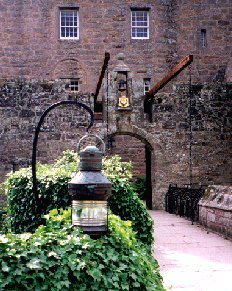
|
Take the narrow stone stairwell down into the very bowels of the castle and you will see the dungeon, as well as an ancient tree with a good story. Legend has it that one day the Thane of
Cawdor set a donkey laden with gold to roam the countryside, saying that
wherever it chose to rest for the night would become the site of his castle.
The donkey lay down by a tree and the castle was built around it.
For many years it was thought to be a hawthorn, but it is in fact a holly tree which died in about 1372. The Cawdor Toast is 'Flourish the Thorn!'
The iron yett here was brought from nearby
Lochindorb Castle around 1455 when the Scottish Privy Council instructed the Thane of Cawdor to dismantle Lochindorb after it had been forfeited by the Earl of Moray.
After passing by the main stairs and through the dining room, then the new and old kitchens, the tour ends with the larder which houses a peculiar mixture of old cycles and fascinating artefacts such as the gardener's snow shoes.
From there you pass through the souvenir shop and then out into the grounds once more. Opposite the shop exit is the walled maze and garden.
|
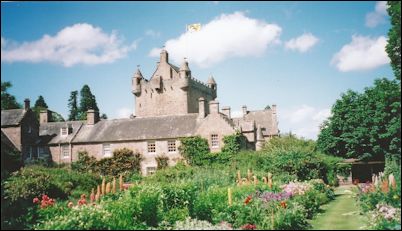 |
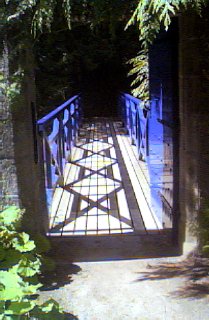
|
Alternatively you can take the path that winds around towards the brown peaty stream known as the Cawdor burn which flows into the River Nairn. Cross over the wooden blue bridge and you will find yourself in Cawdor's vast expanse of woodland. Walk a short distance and you can get a reasonable view of the rear of the castle.
Continue and you can go on one of the signposted nature trails but you will be going the wrong way round to see the markers, so it is better to start on the opposite bank and enter the forest from the door in the main walled garden. That brings you out in the woods at the rear of the castle where a marker board indicates 4 colour-coded trails. You can do a short walk, medium, long or longer! You may find that the blue walk of 2 miles is quite far enough or just opt for the short red trail. Stick to the paths as it is easy to get lost. In wet weather, it may be slippery underfoot in some places. In springtime you will see carpets of bluebells under the trees.
|
|
In colourful contrast to the stony backdrop of the castle, the walled garden provides a wealth of photographic opportunities. In the summer, flower beds of reds, oranges,
purples and whites vie for attention with the tunnel of roses and Copper beeches. In May, the cherry blossom trees sit in pools of fallen pink petals. July and August are the best times to visit to see the most colour in the gardens, but since Scottish summers are notoriously unpredictable, nothing can be guaranteed!
|
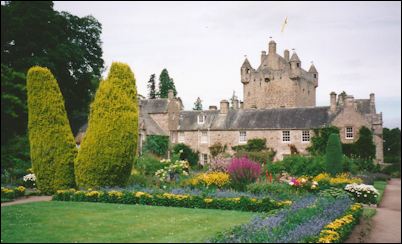 |
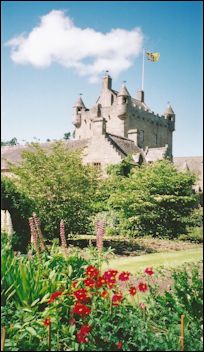 |
Opening times:
Cawdor Castle is open daily from late April to early October.
Disabled access to the grounds and some parts of the castle.
Admission charge for castle and grounds, or for access to the grounds only.
Family tickets and group discount available.
Contact details:
Telephone 01667 404401 / Email:
info@cawdorcastle.com
Visit the official web site at cawdorcastle.com for more info and photos.
|
For information about the Cawdor Estate (including holiday cottages to rent), see
cawdor.com. Please note that accommodation is not available at the castle itself.
|
The castle has a souvenir shop, book shop and licensed restaurant, as well as a picnic area and woollen shop outside the main grounds. The castle's 9-hole golf course (pictured on the right) is also open from June to October and costs 6 pounds for a round.
The official web site includes an online shopping facility for some Cawdor gift items and the most excellent guidebook which is available in several languages.
|
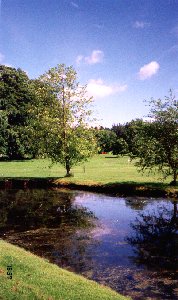
|
Two ghosts are said to haunt Cawdor Castle, one a lady in a blue velvet dress, the other is thought to be John Campbell, the first Lord Cawdor.
For more about the Cawdor thanes and the Calder/Caddell family name, read the article by Bill Caddell which ends with
Muriel's story.
This is one of most fascinating episodes in Cawdor's history and dates back to the end of the 15th century when following the untimely death of the 8th Thane, the sole heiress was his baby daughter Muriel Calder. A party of Campbells forcibly took her from
Kilravock Castle where she was staying with her grandmother at harvest time. Her quick-witted nurse branded her on the hip with a red-hot key so that she could be identified by the family were she ever found again. The tip of her little finger was bitten off to also help with subsequent identification. Only a very young child, she was taken by the men to
Inveraray Castle. In 1510 when she was old enough to be married, she wedded Sir John Campbell, the Earl of Argyll's son.
Despite this traumatic beginning, the 'red-haired lassie' would seem to have enjoyed her life to a large extent. The couple returned to Cawdor in 1524 and Muriel became Thaness of Cawdor herself after her husband died in 1546. She lived until 1575.
Kathryn Lynn Davis has written a novel which encompasses some of this story, particularly the romance of Muriel and John at Kilchurn Castle.
Child of Awe can be bought online as an inexpensive paperback from
Amazon.com and is a good read.
Clan Campbell Castle Page
If you have the opportunity, it is worth looking around Cawdor village and its old church.
|
Travel Info
|
- The Internet Guide to Inverness and Inverness area: sightseeing, transport, tours, etc.
- Local accommodation: B&Bs, hotels, self catering cottages.
- The Internet Guide to Scotland: comprehensive Scottish travel web site.
- Nearby castles: Brodie,
Kilravock, Dalcross,
Inverness, Stuart,
Urquhart
|
|
|